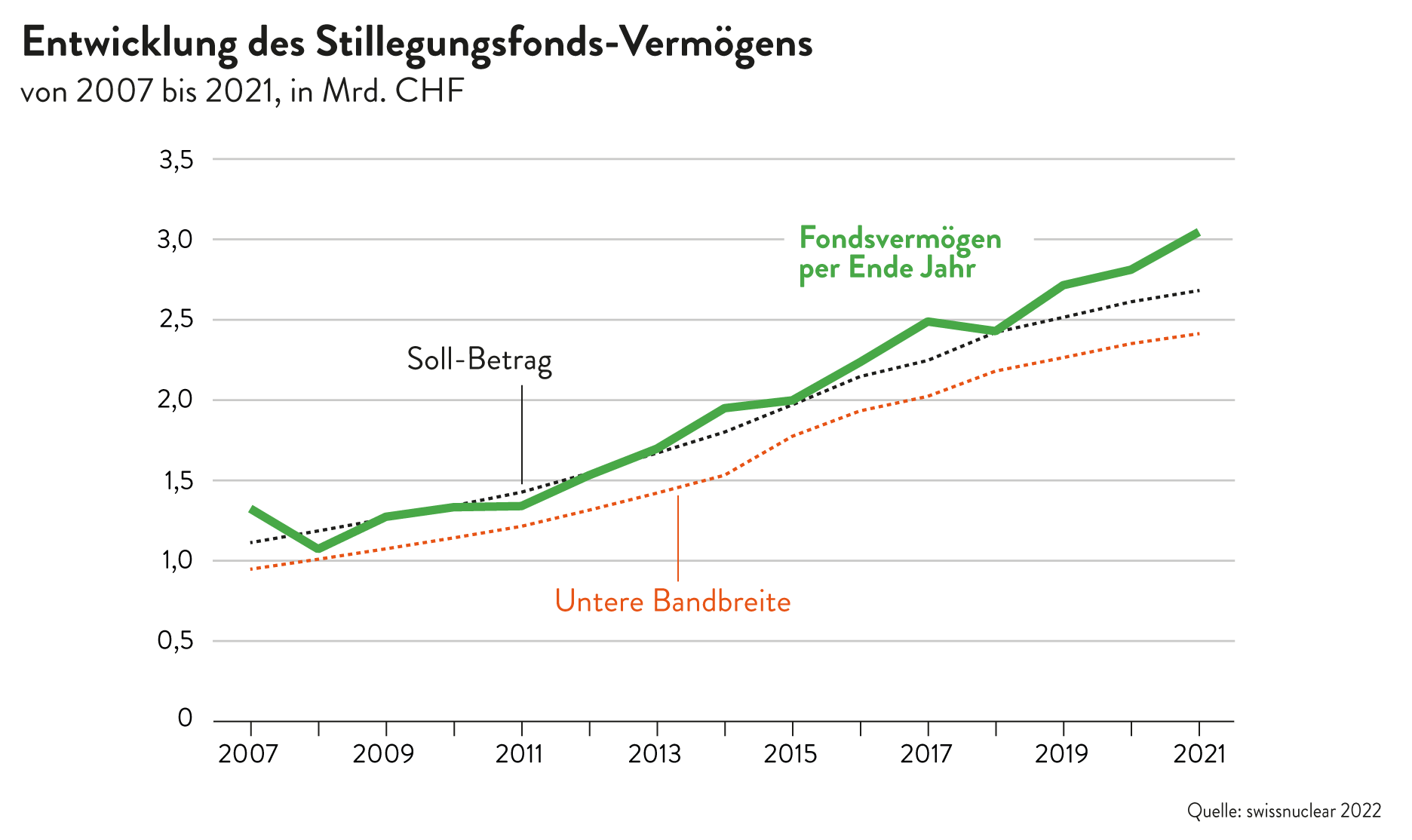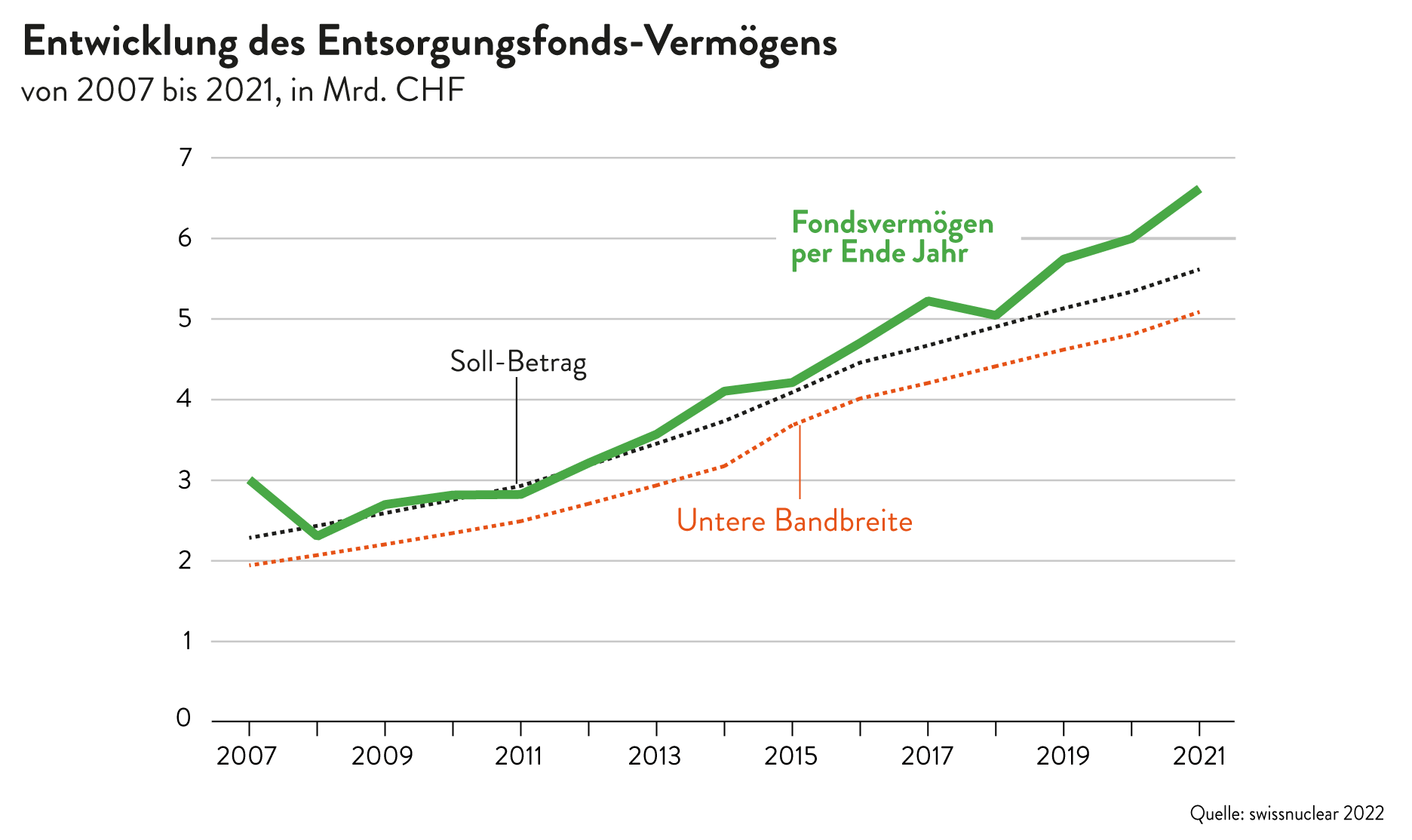The total costs for post-operation, decommissioning and disposal of radioactive waste are included in the price of nuclear power in accordance with the polluter-pays principle. Over an operating period of 50 years, they amount to around 1 centime per kilowatt hour. They are paid directly during the operation of the nuclear power plants on the one hand and pre-financed by the owners of the nuclear facilities via two separate funds on the other.
To finance the costs of decommissioning and disposal, two funds were set up under the supervision of the federal government:
The owners of Swiss nuclear facilities pay annual contributions over 50 years of operation under the supervision of STENFO (Decommissioning Fund for Nuclear Facilities and Disposal Fund for Nuclear Power Plants STENFO). The latter and the returns on the fund assets accrued over time accumulate the funds.
The fund contributions are based on the cost studies, which are updated every five years. They estimate the costs for the decommissioning of nuclear facilities and the disposal of radioactive waste. The procedure chosen in Switzerland, with periodic reassessment of future costs, provides sound and reliable figures.
The Federal Council has defined the modalities and parameters for calculating the cost studies in the Decommissioning and Waste Disposal Fund Ordinance (SEFV). Another binding basis for the cost studies is the disposal program of the National Co-operative for the Disposal of Radioactive Waste (Nagra) approved by the Federal Council.
The targets set by the authorities also take into account the long time horizon for which the calculations are carried out. The long-term targeted average real return on the fund's capital has been 1.6% per year since January 2020 (nominal investment return less inflation). Previous experience with the Decommissioning Fund established in 1985 and the Disposal Fund established in 2002 shows that this real return can be achieved well in the long term.
Over the long term, the funds have developed in line with the target amount defined by the authorities. Thanks to the five-yearly cost studies, the adjustment of the annual contributions paid by the owners of the nuclear facilities as required and a responsible investment strategy, they are on track.


The cost studies are carried out cautiously and to the best of our expert knowledge in the light of current knowledge. This also includes assumptions about the timing of future costs and the estimation of any risk costs. Account is also taken of the unavoidable forecast uncertainties in the estimate. All these cost estimates take into account the fact that the level of technical knowledge and international experience in decommissioning and waste disposal projects is constantly increasing. The uncertainties, on the other hand, are constantly decreasing. In addition, the cost studies are updated every five years. The cost risk therefore becomes smaller and smaller over time.
If unforeseen additional costs nevertheless arise, the owners of the nuclear facilities bear the risk. If one owner becomes insolvent, the other owners are required by law to make additional contributions. The state is only at the end of the five-stage cost-bearing cascade. Only when these additional contributions are not economically viable for an owner does the Federal Assembly decide whether and to what extent the federal government should contribute to the costs.
The funds' payment plan is based on an assumed operating life of the nuclear power plants of 50 years.
In the event of an early definitive decommissioning of a plant, the owner will be treated in the same way when calculating the contributions from 2024 as if he had only decommissioned his plant after 50 years of operation: the contributions will be spread over 50 years. The owners must cover the entirety of the calculated decommissioning and disposal costs with their contributions, regardless of the duration and amount of energy produced.
The investment strategy is determined by the commission of the two funds appointed by the Federal Council, based on the requirements of the Decommissioning and Waste Disposal Ordinance (SEFV). Since 2020, the SEFV has stipulated an average real return of 1.6% per year as the basis for calculation. An operating life of 50 years is assumed for the nuclear power plants.
Investment activities are monitored on an ongoing basis by the Commission's Investment Committee, which is made up of financial experts appointed by the Confederation and those of the owners and is supported by an investment controller. The annual financial statements of the funds are also audited annually by an external auditor and published publicly.
The two funds are geared towards an extremely long-term investment horizon, as the payments